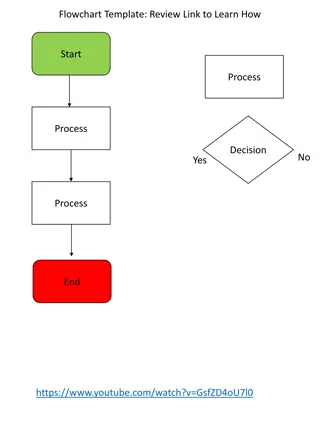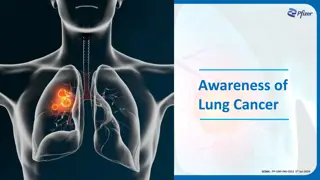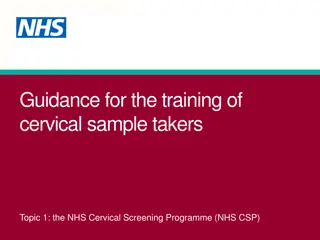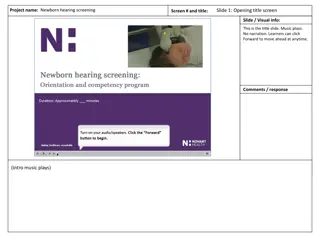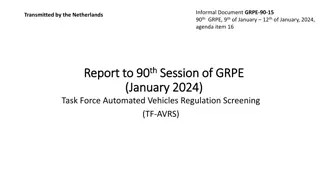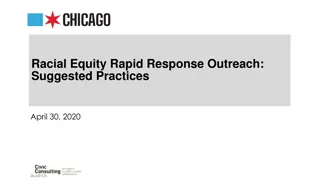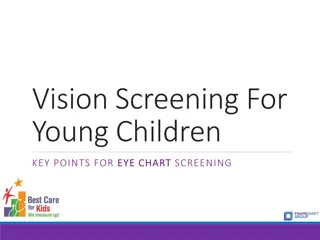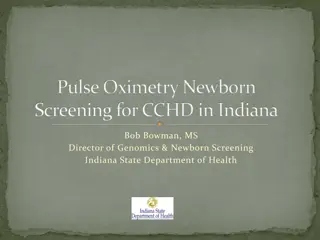SCREENING
Screening and diagnostic tests play a crucial role in identifying diseases and abnormalities in individuals. Learn about the concepts, objectives, outcomes, and differences between screening, case finding, periodic examinations, and diagnosis. Explore the criteria for screening programs and ideal screening tests, along with computing performance metrics. Discover the natural history of disease, levels of prevention, lead time concept, and the importance of periodic examinations.
Download Presentation

Please find below an Image/Link to download the presentation.
The content on the website is provided AS IS for your information and personal use only. It may not be sold, licensed, or shared on other websites without obtaining consent from the author.If you encounter any issues during the download, it is possible that the publisher has removed the file from their server.
You are allowed to download the files provided on this website for personal or commercial use, subject to the condition that they are used lawfully. All files are the property of their respective owners.
The content on the website is provided AS IS for your information and personal use only. It may not be sold, licensed, or shared on other websites without obtaining consent from the author.
E N D
Presentation Transcript
Learning objectives Define the term screening Explain the concept of screening and the lead time Explain the difference between screening , case finding , periodic examination and diagnosis State the uses of screening programs State the criteria of health problems amenable for screening Outline the differences between screening and diagnostic test Distinguish between mass screening and high risk screening State the criteria of an ideal screening test
Performance objectives Compute sensitivity, specificity and predictive values of a screening test Evaluate the performance of a screening test
Screening is defined as the search for unrecognized disease or defect by means of rapidly applied tools in apparently healthy individuals not seeking medical care Tools maybe Test consisting a series of questions Instrument to measure a parameter Medical examination Radiological test Laboratory test
OUTCOME OF SCREENING Screened population Negative Positive Not likely to have the condition Likely to have the condition Further evaluation Discard
Periodic examination Seeking of medical care at intervals to evaluate health status and to detect any health problem without the presence of any complaint. In periodic examination, different systems are looked at and a series of investigations are applied. Case finding The use of a clinical, laboratory or non laboratory test to detect disease in individuals seeking health care for other reasons. The aim of identifying diabetes among pregnant women is an example of case finding. Diagnosis A procedure to confirm or refute the existence of a disease or abnormality among those seeking medical care with a specific complaint. Achieved by obtaining medical history, clinical examination and the application of laboratory or non laboratory tests.
SCREENING & DIAGNOSTIC TEST Screening tests Applied asymptomatic Diagnostic tests Applied to those with specific complaint or suggestive signs or symptoms to apparently healthy or Applied to a group of individuals Applied to a single person Results are based on one criterion Results are based on the evaluation of a number of symptoms, signs and result of investigations Results are not conclusive Results are conclusive and final Less accurate More accurate Less expensive More expensive Not a basis for treatment Basis for treatment
USES OF SCREENING TESTS Case detection; It is identification of unrecognized disease or defect that doesn t arise from patients request Control of diseases; This is with the purpose to prevent the transmission of the disease to healthy community members Research purposes; initial screening is conducted to estimate the prevalence of a disease and subsequent screening will provide data on the incidence
TYPES OF SCREENING PROGRAMS Mass screening; applied to the whole population or population subgroups as adults, school children, industrial s workers irrespective of their risk. High risk or selective screening; applied to a selective population subgroups who are at a high risk. Among high risk population, the disease is more likely to be prevalent and the screening will result in a better yield.
Eligible conditions for screening Major public health problem and/or have serious consequences High prevalence among screened population Have a detectable pre-clinical phase Availability of test for detection in pre-clinical phase Evidence that early detection reduces morbidity and mortality Available facilities for the confirmation of the diagnosis Agreed-on policy whom to treat as a patient Available of effective treatment for the disease if identified Expected benefits of early detection out-weight the risks and costs of screening
Example of screening programs Blood pressure for hypertension Fasting blood sugar level for diabetes Pap smear for cervical cancer Mammogram for breast cancer PSA for prostatic cancer Elisa followed by RIBA for hepatitis C antibodies Thyroid hormone from blood cord for hypothyroidism in newborn Hip examination for congenital hip dislocation in the newborn
Characteristics of an ideal screening tool Feasibility Simple, inexpensive, capable of wide application Acceptability Acceptable by the people to whom it is intend to be applied Reliability (precision) Consistent results on repeated application on the same individual under same circumstances Validity (accuracy) Ability to distinguish between those who have and those who don t have the disease as confirmed by a gold standard
Validity of the test reflects its accuracy compared to a gold standard. Validity has two components Sensitivity: ability of the test to detect correctly those who truly have the condition (true positive) Specificity: ability of the test to detect correctly those who truly don t have the condition (true negative)
Screening test results Gold standard Total Diseased a True positive c False negative a+c Not diseased b False positive d True negative b+d 16 Positive a+b Negative c+d Total a+b+c+d Sensitivity: ability of the test to detect correctly those who truly have the condition (true positive) Sensitivity= ?+? ? Specificity: ability of the test to detect correctly those who truly don t have the condition (true negative) Specificity = ?+? ?
Sensitivity: Breast cancer Positive 900 100 1000 17Test Total Negative 1980 97020 99000 the test was capable to identify correctly Positive Negative Total 2880 97120 100000 90% of the those who have the condition ? The false negative rate ( ?+?) is only 10% (900/1000)x 100 = 90.00% Sensitivity Specificity: (97020/99000) x 100 = 98.00% Specificity the test was capable to identify correctly 98% of the those who don t have the condition ? The false positive rate ( ?+?) is only 10% EXAMPLE
Sensitivity: Breast cancer Positive 900 100 1000 18Test Total Negative 1980 97020 99000 A sensitive test will result in few false negative Positive Negative Total 2880 97120 100000 Test with high sensitivity is preferable in screening (900/1000)x 100 = 90.00% Sensitivity Specificity: (97020/99000) x 100 = 98.00% Specificity A specific test will result in few false positive Test with high specificity is preferable for diagnosis EXAMPLE
Yield of the test reflects the number of correctly unrecognized subjects with the condition who have been identified and brought into care Yield of the test is measured by its predictive value Predictive value positive (Pv+ve) is the probability that a person positive by the test truly have the condition ? Pv+ve= ?+? Predictive value positive (Pv-ve) is the probability that a person negative by the test truly don t have the condition ? Pv-ve= ?+?
Pv+ve: Breast cancer Positive 900 100 1000 20Test Total Negative 1980 97020 99000 Out of those who are positive by the test Positive Negative Total 2880 97120 100000 only 31.25% were found to have the condition (900/1000)x 100 = 90.00% Sensitivity (97020/99000) x 100 = 98.00% Specificity Pv-ve: Out of those who are negative by the test, (900/2880) x 100 = 31.25% PV + ve 99.89% were found to be free from the PV ve (97020/97120) x 100 = 99.89% condition EXAMPLE
Low predictive value positive of a test is a waste of resources; very few of those who tested positive will be found to have the condition High predictive value positive is desirable in screening program; detecting and bringing into care subjects with the condition at a pre-clinical stage Predictive value positive increases considerably with the increase in the prevalence of the condition among the screened population In condition with relatively lower prevalence among the general population but higher prevalence among high risk population, it is recommended to avoid mass screening and to opt for selective screening of high risk population
Breast cancer (Prevalence 1%) Positive 900 100 1000 Breast cancer (Prevalence 10%) Positive 9000 1000 10000 22 Test Total Test Total Negative 1980 97020 99000 Negative 4500 85500 90000 Positive Negative Total 2880 97120 100000 Positive Negative Total 13500 86500 100000 (9000/10000) x 100 =90.00% Sensitivity (900/1000)x 100 = 90.00% Sensitivity (97020/99000) x 100 = 98.00% Specificity Specificity (85500/90000) x 100 = 95.00% (900/2880) x 100 = 31.25% PV + ve PV + ve (9000/13500) x 100 = 66.67% PV ve (97020/97120) x 100 = 99.89% PV - ve (85500/86500) x 100 = 98.84% PREVALENCE & PREDICTIVE VALUE
False positive results are referred to as adverse effects or errors of screening False positive result is not desirable It is a waste of resources; incurring the cost of the screening and the confirmation of the diagnosis Unnecessary exposure of subjects to the hazards of the tests Emotional strain of being a probable case False negative result is not desirable Giving a false re-assurance that they are free from the condition
True positive result is desirable It is money well spent Bringing subjects with the condition into care Subjects who incurred the hazards of screening and confirmation of the diagnosis will benefit from therapeutic intervention True negative result is desirable Re-assurance that they are free from the condition


